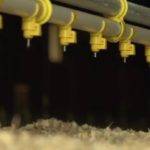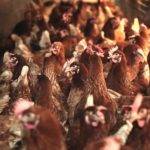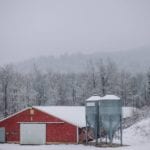
Creative Problem Solving for Frozen Feed
This week farmers across the countries endured possibly the worst thing about winter: bitter freezing cold. Some parts of the Midwest were colder than Antarctica. In Pennsylvania, it was in the negative double digits. Frigid temps cause frozen everything, the worst of which might be frozen feed lines. And the worst thing about frozen feed […]
Read More >
Wet Litter & Antibiotic-free… BFFs?
Litter serves many roles in a poultry barn – insulation, dust bath, scratch area, and importantly, moisture absorber. This last role is important because houses that are too dry are dusty and can lead to higher incidences of respiratory disease in birds, but too wet leads to ammonia-related illnesses including footpad dermatitis, breast blisters, and […]
Read More >
The steep temperature difference between internal house air and external fresh air can often result in condensation around inlet openings or in the attic of the barn. Aside from being a bit frustrating to fix, it can have a serious consequence on your flock health and performance, because they are not receiving the fresh air […]
Read More >
Optimizing Attic Inlet Performance
Winter ventilation comes with a unique set of challenges. Incoming air is cold and dry, heaters seem like they are always running, and the cost of fuel is only going up. Attic inlets are sometimes used to minimize the use of heaters. The idea is that the sun would warm the attic air, which would […]
Read More >
Grower Spotlight: Matt & Karen Moeller
Matt Moeller and his wife, Karen, are integral members of the South Dakota hog farming community. A farmer from birth, Matt grew up with pigs on the family farm, and often worked with his father and uncle caring for the livestock. Today, Matt raises wean-to-finish hogs, without antibiotics, for Smithfield Foods. His farm has 11,000 […]
Read More >
Effective Production Starts with Biosecurity
Antibiotic-free farming is on the rise, and so are the incidences of potentially devastating diseases. Because treatment is not always an option, prevention is key, and it starts with strong biosecurity practices. Here are some points to keep in mind when designed biosecurity protocols: Keep your distance – Restrict access to property and livestock to […]
Read More >
Improve winter brooding with air and litter quality
Winter farming comes with a unique set of challenges, especially where litter and air quality are concerned. Respiratory diseases are common in winter when there is less ventilation, and their prevalence has only been increasing since the use of antibiotics has been on the decline. Brooding is arguably the most important developmental stage and eliminating […]
Read More >
Is your water line the right height?
Before we get started on why drinker line height is so important, there are a few facts you need to know: One: Chickens consume 1.75 pounds of water for every pound of feed. This is a constant. Two: Chickens have a maximum rate at which they can consume water, and this rate changes with age. […]
Read More >
Of all of the health problems found in poultry, one of the most common is coccidiosis. It’s a parasitic disease cause by protozoa found in feces. Consumption of contaminated food or other particles continues the cycle. Coccidiosis is a manifestation of Eimeria, a genus of apicomplexan parasites. Various strains of the disease present more severely […]
Read More >
Infographic: Poultry Watering 101
Want to learn more about poultry watering? Check out the Ultimate Poultry Watering Guide. Subscribe to our blog!
Read More >
Winter Blues: Diseases to look out for
We’re coming into winter, and humans are not the only animals spreading germs and catching colds. Your birds are doing it, too. Unfortunately, there is no escaping a sick neighbor in the poultry house. We help our feathered friends out by practicing good biosecurity, but disease can still find its way into a flock. To […]
Read More >
Brooder cleaning is one of the most important tasks done on the farm. Brooders rapidly lose heating efficiency when they are dirty. Routine maintenance ensures you get the most out of your heating equipment and prevents fire hazards. Brooders should be cleaned and inspected before every flock. Regardless of what they look like on the […]
Read More >
3 Secrets to Winter Ventilation
Air quality is heavily dependent on humidity Humidity is the culprit for many of the respiratory issues found in poultry flocks. It amplifies the presences of ammonia and carbon dioxide and makes it difficult for birds to regulate their own body temperatures. Air quality is important especially during the colder winter months, when minimum ventilation […]
Read More >
18 Egg Facts for Egg Day 2018 1. Eggs are good for your eyes. They contain lutein which prevents cataracts and muscle degeneration. 2. An egg shell can have as many as 17,000 pores. 3. Egg shell and yolk color can vary but have no effect on taste […]
Read More >
Poultry Watering: Understanding Iron
Iron can be found in wells and municipal water all around the world. Sometimes it is obvious – the water runs red in the sink, often having a distinctive taste and smell. Sometimes it is less obvious – but still leaves its mark in the form of reddish-brown discoloration on appliances. While mostly harmless, it […]
Read More >
Poultry Watering: Understanding pH
You’re probably aware of the importance of pH, especially when talking about watering systems and treatments. But how well do you really understand it? pH is the abbreviation of “power of hydrogen” (the ‘H’ is capitalized because it represents the element symbol of hydrogen, and it is standard to capitalize those). pH measures the hydrogen […]
Read More >
How-To: Clean & Maintain A Water Line
So many factors can affect the quality of poultry flock, but water is the most important. It’s easy to take for granted, especially in areas where water quality isn’t a daily concern. Drinkable quality and high quality are not the same, though. Paying close attention to the quality of the water will always result in […]
Read More >
Poly belt care for cleaner eggs
Recently, there have been many food recalls due to contamination such as e.coli and Salmonella. Controlling the spread of these diseases – to consumers and to other flocks – requires a careful cleaning and disinfecting program through every step of the rearing process. Every farm has its own checklist of chores to complete in between […]
Read More >
Litter Management to Improve Flock Health
The reduction in antibiotic use in poultry farming requires a reduction in bacteria and pathogens that birds are exposed to. One way to do this is to tighten biosecurity. Another method is to improve litter management. Modern poultry farming often uses bedding for repetitive flocks. Chickens shed bacteria in their excrement, exposing subsequent flocks to […]
Read More >
Bryan is the Owner/Operator of 8 broiler barns in northwest Arkansas. His farm has been in operation for just about two years and has just finished its 10th flock. Every single flock has finished in the top 3, and he attributes his success to the VAL-CO system. Each of his 46×520 houses are equipped with […]
Read More >